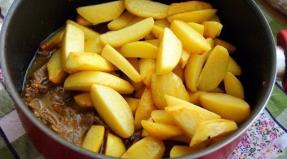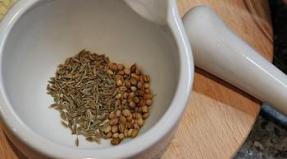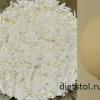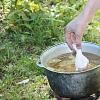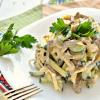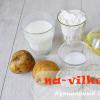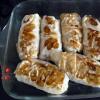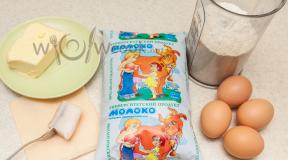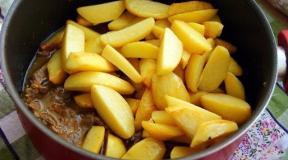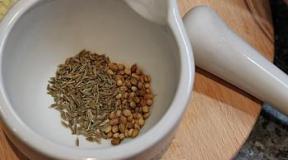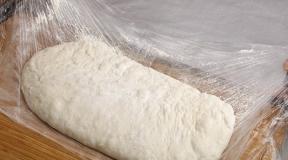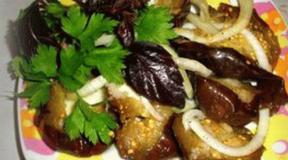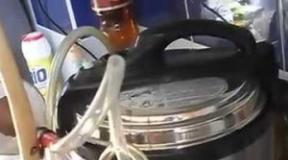Ciabatta – description with photo and calorie content; cooking real and quick Italian bread (video recipe); what the product is eaten with; benefit and harm. Ciabatta bread in the oven How to bake ciabatta at home
Italian bread with a porous, elastic crumb and a brittle, dry crust has the beautiful name ciabatta. This type of baking has become widespread not only in the sunny country, but also far beyond its borders. You can prepare this type of bread at home. The recipe will require the simplest ingredients, time, patience and a great mood. To ensure perfect baking, do not rush, avoid fuss, observe proportions and time frames. With the help of proven recipes, you can please yourself and your family with aromatic and delicious Italian bread.
What is ciabatta
In sunny Italy, special ciabatta bread is baked from wheat flour and yeast. The peculiarity of this pastry is its crispy crust and soft, elastic interior with uneven porosity. This type of baking can be completely different: have a hard crust and dense pulp or be light and soft. You can recognize Italian ciabatta by its characteristic light aroma of rye malt and delicate, slightly salty taste.
The standard shape of an Italian loaf is elongated and flat. The width is about the palm of your hand, and the length is about 20-250 cm. The weight of the finished product is 350 grams. To make a sandwich, cut this bun in half to make 2 large servings. Such baked goods are often used to prepare bruschettas, croutons, croutons, which are served with various sauces and gravies.
How to bake ciabatta at home
According to the classic recipe, ciabatta is baked in an oven on stones. This heat treatment method promotes uniform heat distribution. The crust becomes golden on all sides. It’s difficult to implement an authentic method of preparing ciabatta at home, but in the oven the treat will turn out just as good. First, the dough is kept for 12 hours, then the dough is kneaded to the desired consistency.
The kneaded dough should double in volume before starting to form the ciabatta loaf. Parchment paper is generously sprinkled with flour, the dough is laid out, stretching it into a rectangle shape. Using stands (glasses), cover the dough with a damp towel so that the fabric does not touch the knead. The dough remains in this position for 2 hours. Afterwards, the formed mass on a baking sheet is sent to the oven.
Ciabatta dough
Traditional white Italian pastries with large “holes” inside and a crispy crust on the outside are obtained thanks to a special dough preparation technology. The mass should be soft, watery, similar to pancake dough, and the peeling period should be at least 12 hours. The composition of ciabatta products differs little from the types of bread familiar to Russians: flour, salt, water, yeast (sourdough). Additional components can be milk or cream, olive oil, cheese, spices, herbs, olives.

Ciabatta recipe
There are several options for ciabatta, which are prepared on the basis of classic dough with the addition of herbs, mozzarella, sun-dried tomatoes, and olives. The cooking process, although it takes a lot of time, is not difficult to implement. The dough used is liquid; it does not need to be kneaded for a long time or tediously. Even a beginner who knows the basics of culinary art can cope with a detailed recipe without photos for baking Italian ciabatta. Follow the instructions exactly, keep the proportions, cook with pleasure to get delicious and aromatic Italian bread.
Recipe in the oven
- Time: 15-16 hours.
- Calorie content of the dish: 262 kcal/100 g.
- Purpose: baking.
- Cuisine: Italian.
- Difficulty: easy.
Soft, porous with a crispy crust, hot ciabatta will be an ideal base for sandwiches with sausage, ham, and fish. Various types of sandwiches are made from it and simply served with first courses and salads. The recipe for ciabatta in the oven at home is based on the simplest ingredients. If you want to achieve authentic porosity and airiness, use special flour with a high protein content. Due to the large amount of proteins, not only does the desired structure appear, but also the calorie content of the product is reduced.
Ingredients:
- wheat flour – 0.5 kg;
- dry active yeast - 0.5 tsp;
- sugar – 0.5 tsp;
- salt – 1 tsp;
- warm water – 350 ml;
- olive oil – 30 ml.
Cooking method:
- Mix flour with yeast, add salt and pepper.
- Add oil and water to the dry ingredients in a thin stream, stir with vigorous, quick movements until smooth.
- Cover the bowl with the dough with a towel, leave the dough at room temperature to ferment for a long time, preferably about 12 hours.
- Dust a sheet of parchment paper with flour. Lay out the thick dough and gently stretch it, giving it the shape of an elongated rectangle.
- The dough needs to be tucked with the edges toward the center: top and bottom first, then left and right.
- Turn the dough seam side down and cover with a towel. Let rise warm for about 2 hours.
- The mass should increase in volume twice. Divide it into 2 or 3 parts with a knife, sprinkle the sides with flour.
- Place a cast iron frying pan with water on the bottom of the preheated oven and bake the ciabatta at 230 degrees for 25-30 minutes.

Ciabatta with cheese
- Time: 4 hours.
- Number of servings: 5-6 persons.
- Calorie content of the dish: 278 kcal/100 g.
- Purpose: baking.
- Cuisine: Italian.
- Difficulty: easy.
The ciabatta bread recipe does not require any special cooking skills. The main thing is to have patience and endurance, because the baking dough must rise several times. Experienced housewives recommend working with yeast dough only in a good mood. Then you will end up with a dry, brittle crust and crumb with pores of different sizes. Cheese added according to the recipe makes the dough heavier, so experts do not recommend baking rolls that are too large in order to maintain the necessary porosity.
Ingredients:
- flour – 270 g;
- hard cheese – 50 g;
- water – 200 ml;
- dry yeast – 7 g;
- salt – 7 g;
- fresh thyme - 2 sprigs.
Cooking method:
- Pour warm water over the yeast and stir.
- Add salt to flour, slowly pour dry ingredients into liquid.
- Stir the liquid dough thoroughly.
- Grate the cheese on a fine grater, chop the thyme. Add these ingredients to the previously prepared mixture.
- Cover the container with the dough with cling film and place in a warm place for an hour. To allow the mass to breathe, make several punctures with a toothpick.
- Using a spatula, gently lift the dough up and toward the center. Normally it will blur back.
- Cover the container again using film and leave in a warm place for another 2 hours.
- Sprinkle the table with a thick layer of flour and place the dough on top.
- Fold the mass into a square or rectangle, lifting the edges and folding them into the center. Dust the top with flour.
- Divide the resulting workpiece into 3 equal parts.
- Next, you need to carefully place the blanks on a baking sheet with parchment. Separate the buns with a layer of baking paper. They should round and increase in size as they bake.
- Leave the bread to separate for another 20 minutes. If the dough spreads, it needs to be supported with a towel.
- Set the oven temperature to 200 degrees. Bake the dough for 15-20 minutes.
- To check if the baked goods are done, tap the surface of the crust. A dull ringing sound should be heard.
- The bread should be cooled before serving.

Cooking secrets
Even if you follow all the rules of the recipe, the baked goods may turn out non-porous and may not have a beautiful, golden brown crust. To get perfect ciabatta, like the one served in Italian cafes, use a few recommendations from professional chefs:
- To form a tender crust, place a cast-iron frying pan with water on the bottom of the oven. Wide dishes will create the effect of a steam bath.
- A little olive oil added at the end of kneading will soften the dough and bring out new flavors.
- It is better to bake Italian bread in the oven on a special stone. It will distribute the heat evenly, and the dish will cook faster on it.
- Yeast dough does not tolerate drafts. Avoid any air movement throughout the entire cooking process.
- The ideal air temperature for the test in question is +24 degrees.
- When forming the buns, be careful not to press down the mixture to maintain porosity.
- Do not use convection in the oven when baking, it will significantly reduce the fluffiness of the bread.
- For the baked goods in question, it is better to purchase special flour with a high protein content.
- It is important to observe the proportions of the recipe. If there is too much yeast or the flour-water balance is not correct, the top of the bread will fall off during baking.
- Do not open the oven door until the end of the ciabatta baking time specified in the recipe to prevent the dough from falling.
Video
In full screen
I've always loved Ciabata bread. Probably due to the fact that it is similar to a type of bread that I ate as a child. So I became interested in cooking it. Just like white bread, the ciabatta didn’t turn out right the first time. Oddly enough, there are a great many recipes for ciabatta on the Internet. And everyone is different. They say that you need to use a special mixture. I was skeptical about this and continued searching. And suddenly it dawned on me. And who else but the Italians knows how to cook ciabatta correctly? And I began to collect information bit by bit.
In full screen
This is what I dug up. Firstly, the dough for ciabatta is much more “liquid” than for bread. Secondly, the ciabatta dough must rise for at least 18 hours. Thirdly, the dough is not kneaded, but simply mixed. Before the second proofing, it just needs to be shaped. Fourthly, during the second proofing, the dough is covered with a towel and left to rise for another 2 hours. Fifthly, the dough should prove for the second time on the pie sheet (the pie sheet heats up faster). Sixth, the baking temperature is 220 degrees Celsius and above, the baking time is 35-40 minutes. The color of the rind should be gray-brown and quite dark. Seventh, be sure to cool on a wire rack until completely cool.
In full screen
But! I won't wait that long and will make a "quick" version. When I read about the easy version, I was very surprised! Try it! Truly they say that everything ingenious is simple! (I was simply blown away when such a simple option produced a VERY good result)
In full screen

So - Ciabata - without kneading the dough. Oddly enough, I found the recipe I liked best on Youtube. I just typed in Ciabatta and saw a wonderful video of two kids making bread. Of course, I was amazed that they did not knead the dough at all, but simply mixed it in a container. I’ll make a reservation right away. I don't like bread to be too fluffy, so my ciabatta is just the way I like it. How to achieve this - see the explanations for proofing the dough.
In full screen

In full screen

Mix most of the flour and water. Add salt and the rest of the flour and stir with a whisk, fork or spatula for a couple of minutes.
In full screen

In full screen

Ambient temperature is important here. In general, it should defrost at a temperature of 25-30 degrees. But, since I like the bubbles to be larger than in regular white bread, but not too big, I just leave it at room temperature. Alternatively, you can preheat the oven to 25-30 degrees (three minutes on low heat) and place the container with the dough inside. This way you will also get rid of drafts. After proofing, remove the film from the pan. Sprinkle the table with flour. Using a spatula, lift the dough from the edges and “cut” it from the surface of the mold until the dough separates from the mold and falls onto the table, being careful not to put too much pressure on the dough. Divide the dough into two parts with a spatula or knife. Place baking paper in a baking tray. Sprinkle with flour.
In full screen

Next, proceed very carefully, trying not to wrinkle the dough. Gently place the dough onto the flour. Shape the dough into an oval. Don't try to make it too straight. Be careful not to allow any air bubbles that have already formed to escape from the dough. Dust the top of the ciabattas quite liberally with flour.
In full screen

- 1. Knead the dough using the ingredients. Don't forget that the ciabatta dough should be liquid. When kneading, do not add all the flour to the dough at once. Flour, depending on its variety and quality, absorbs water differently. Therefore, you may need a little more or a little less flour from the total amount indicated in the recipe. Our task is to get a very, very sticky dough, approximately the same as in photo No. 3. Do not be afraid! The dough won't stick to you in a death grip. It will come unstuck!
- 2. Kneaded?! No? You need to knead. Five minutes, or better yet ten. The quality of bread improves when kneading. So we knead. In a dough mixer, in a blender with attachments or by hand. Kneaded?! Now cover with a clean napkin and leave for 10-12 hours in a warm place. Instead of a napkin, I learned to use a glass lid from a frying pan. Through the glass I see how the dough grows and rises

- 3. The piece of dense and sticky dough has doubled in volume. The dough has puffed up and air bubbles are visible on the surface. Inhale this aroma and you will understand why such a long fermentation is necessary.... mmm... Oh, that smell of freshly fermented dough!

- 4. Spread cling film on the work table. To prevent it from shrinking and crawling, spray the surface with water. Sift some flour onto the film and...

- 5. ...add the dough.

- 6. Just look at what a blunder! Despite its liquid state, the dough does not spread and holds its shape perfectly. It is convenient and easy to work with

- 7. Sprinkle flour on top of the dough. Form a loaf. You can divide the dough into two parts and get two loaves, naturally a little smaller in size :)

- 8. Cover the baking sheet with paper. Drizzle with oil and sprinkle with flour.
- 9. Carefully move the future ciabatta onto a baking sheet and straighten the shape. Leave for another two hours in a warm place under a napkin for final proofing. Don't worry if the dough looks "flat". The ciabatta will expand and “bubble” in the oven!

- 10. Place a tray with water on the bottom shelf of the oven and bake for 30-35 minutes at 220 degrees
- 11. Here it is, a real Italian slipper. Handsome!

- 12. Enjoy your ciabatta! :) Agree, after the taste of freshly baked ciabatta, prepared at home, the sliced loaf is not the same!

- 13. Did you like the recipe? I would be very grateful if you rate the recipe and/or write a comment. Thank you! :)
How to bake homemade ciabatta in the oven
It is convenient to use the simplest recipe as the basis for homemade ciabatta. It does not require much effort to knead the bread dough, but it does require time for fermentation. It is optimal to leave the dough for an hour at eight or nine in the evening. In the morning, form the ciabatta and bake it. Thus, by about eight in the morning there will be delicious fresh bread with a crispy, toasted crust and a tender crumb with “holes” that are similar to holes in good cheese.
Attention! The volume of the pan should be five times larger than the volume of the dough when kneading.

1. Pour yeast into water. The water should be slightly warmer than the room temperature, about 30 degrees.
2. Add flour and salt. Mix the dough with a spoon or spatula without kneading it with your hands or removing it from the pan. The dough is more liquid than for other types of bread.
3. The ciabatta dough will take approximately 7 - 8 hours to rise.

4. When this process is over, you need to take a baking sheet. Cover it with baking paper and pour a few tablespoons of flour onto it.

5. Carefully remove half of the dough.

Place it on the flour and fold all four edges up, forming a more rectangular ciabatta.


Do the same with the second part of the test.

6. Once formed, the ciabatta sits for another hour.
7. Place a tray on the bottom of the oven. Pour about one cm of water into it. This is necessary to ensure maximum rise of the ciabatta while cooking in the oven. In Italy, ciabatta is prepared in wood-burning ovens, which provide the bread with a spongy soft crumb and a crispy crust.
Place the baking tray with bread in the center of the oven. Set the maximum temperature. As a rule, in household ovens this is +240.
8. Once the top crust turns brown, turn off the heat.

Leave the ciabatta there for about an hour.
The resulting Italian ciabatta bread will be so delicious that you can eat it in an instant.


Today I want to offer you a recipe for ciabatta in the oven, which is made with batter. It doesn’t take long to prepare, if you don’t take into account the time it will just stand for rise. All the cooking processes are not very complicated, so if you have ever worked with dough, then you will definitely succeed.
This recipe for ciabatta at home is in the oven, and you can even bake it in a slow cooker if that’s more convenient for you, but in this case I won’t tell you the baking time and the mode in which this is done.
The recipe for ciabatta bread was sent to me by Nadyusha, who often bakes it for her family. And with bread, I like to experiment to find the perfect cooking methods. I don’t like buying it in the store, because I’m used to homemade bread, and the bread they sell is often not tasty at all. I also really like the aroma of freshly baked bread.
Ingredients:
- Wheat flour – 360 g
- Salt – 1 tsp
- Dry instant yeast – 0.5 tsp
- Water – 350 ml.
How to bake ciabatta at home
It is more convenient to make ciabatta dough in the oven in a large bowl, as it will expand. To begin with, I pour flour, dry yeast and salt into it. Next, I mix them well so that the yeast is evenly distributed in the flour.
 After this, pour water into the dry mixture and mix with a spatula until smooth. The water temperature should be 35 - 40 degrees and no higher, it should be warm to the touch. The dough is not thick and you don’t need to knead it for a long time, and especially don’t even think about adding flour.
After this, pour water into the dry mixture and mix with a spatula until smooth. The water temperature should be 35 - 40 degrees and no higher, it should be warm to the touch. The dough is not thick and you don’t need to knead it for a long time, and especially don’t even think about adding flour.
 Then I cover the bowl with the dough with cling film, which needs to be pierced in several places to allow air to enter. The holes should be small and it’s easier to make them with a toothpick. Thanks to this, the dough rises better and there will be no excess moisture inside. I leave it at room temperature for 12 – 18 hours and no less. It is most convenient to do it in the evening, so that you can begin the next processes in the morning.
Then I cover the bowl with the dough with cling film, which needs to be pierced in several places to allow air to enter. The holes should be small and it’s easier to make them with a toothpick. Thanks to this, the dough rises better and there will be no excess moisture inside. I leave it at room temperature for 12 – 18 hours and no less. It is most convenient to do it in the evening, so that you can begin the next processes in the morning.
 After the specified time, the entire dough will be covered with small bubbles, as it should be. Do not stir it under any circumstances.
After the specified time, the entire dough will be covered with small bubbles, as it should be. Do not stir it under any circumstances.
 I sprinkle the silicone mat with flour and pour the batter onto it. Next, you can proceed in two ways. In the first case, using two wide spatulas, I transfer the bread to a baking sheet with parchment, which also needs to be sprinkled with flour in advance. In the second case, everything is a little more complicated and longer. But thanks to the detailed description, this recipe for ciabatta at home will not become something very difficult for you, but will definitely work out.
I sprinkle the silicone mat with flour and pour the batter onto it. Next, you can proceed in two ways. In the first case, using two wide spatulas, I transfer the bread to a baking sheet with parchment, which also needs to be sprinkled with flour in advance. In the second case, everything is a little more complicated and longer. But thanks to the detailed description, this recipe for ciabatta at home will not become something very difficult for you, but will definitely work out.
 Use a spatula or hands to form a round loaf. To do this, I wrap the edges of the dough into the center, as if gathering it inside. From these products you can make one large or two small loaves. To prevent the dough from sticking to the spatula, I constantly sprinkle flour on the edges of the product. And movements must be sharp. If you don't have a mat, shape the bread on a well-floured kitchen counter. Next, I leave it for 15 – 20 minutes, also sprinkling a little more on top. After the specified time, I check the readiness of the dough: I lightly press the dough with my finger, it should spring back - the hole is immediately restored to half its depth, and then straightens out more weakly. If not, wait a little longer. Then I divide the dough into 2 parts and carefully form rectangles.
Use a spatula or hands to form a round loaf. To do this, I wrap the edges of the dough into the center, as if gathering it inside. From these products you can make one large or two small loaves. To prevent the dough from sticking to the spatula, I constantly sprinkle flour on the edges of the product. And movements must be sharp. If you don't have a mat, shape the bread on a well-floured kitchen counter. Next, I leave it for 15 – 20 minutes, also sprinkling a little more on top. After the specified time, I check the readiness of the dough: I lightly press the dough with my finger, it should spring back - the hole is immediately restored to half its depth, and then straightens out more weakly. If not, wait a little longer. Then I divide the dough into 2 parts and carefully form rectangles.
 I bake them in a preheated oven, at 250 degrees, 15 minutes with steam. And to make steam, just place a deep bowl with boiling water on the bottom of the oven. It is important that the dishes are intended for the oven, since not everyone can withstand high temperatures. After this, reducing the temperature to 220 degrees, remove the dishes with water and bake for another 15 minutes. Next, I carefully remove it from the oven and leave it to cool. As you can see, Italian ciabatta bread is not at all difficult to make, but if you are preparing it for the first time, then first read everything carefully and only after that, start cooking.
I bake them in a preheated oven, at 250 degrees, 15 minutes with steam. And to make steam, just place a deep bowl with boiling water on the bottom of the oven. It is important that the dishes are intended for the oven, since not everyone can withstand high temperatures. After this, reducing the temperature to 220 degrees, remove the dishes with water and bake for another 15 minutes. Next, I carefully remove it from the oven and leave it to cool. As you can see, Italian ciabatta bread is not at all difficult to make, but if you are preparing it for the first time, then first read everything carefully and only after that, start cooking.
 I hope you liked the recipe for ciabatta in the oven and you will prepare it for your family. This is such an unusual Italian bread. And inside it has big holes, which looks quite interesting. Try it too, and I will be glad if my recipe becomes one of your favorites. Bon appetit!
I hope you liked the recipe for ciabatta in the oven and you will prepare it for your family. This is such an unusual Italian bread. And inside it has big holes, which looks quite interesting. Try it too, and I will be glad if my recipe becomes one of your favorites. Bon appetit!
